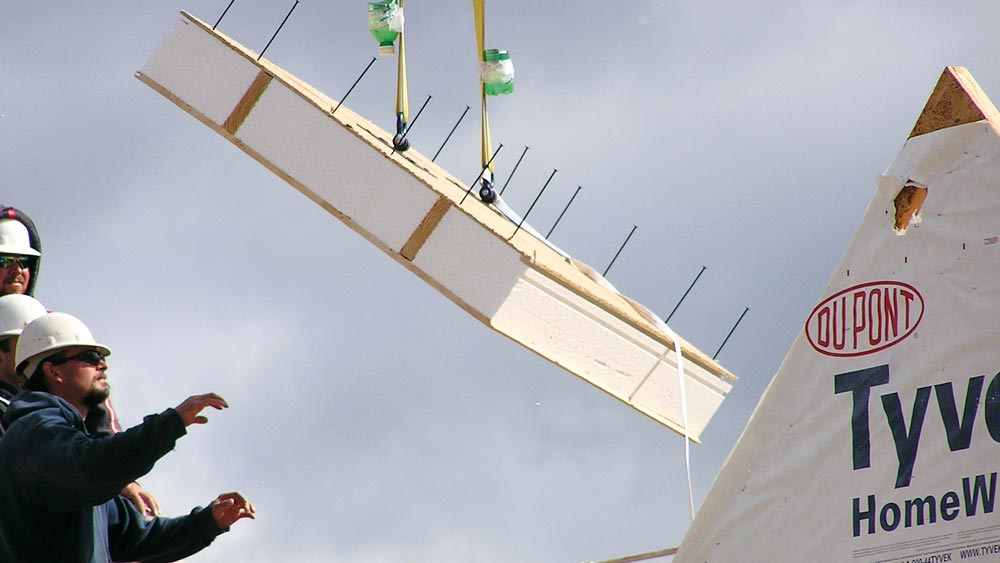
Eagle Panel SIPs photo
Of all the things your timber home should be — sturdy, beautiful, comfortably furnished — there’s one adjective that should never make the list: cold. There’s a solution for that, and it can be summed up in three words: structural insulated panels, aka, SIPs.
We’ve been trained to think of the energy performance of a structure in terms of R-value. The R-value is the resistance to the transfer of heat and is used to measure thermal resistance in a specific product. The higher the R-value, the greater the ability a material has to resist the transfer of heat in or out of a building.
But R-values alone don’t tell the full story. How an insulating material is used affects its ability to retain its R-value and perform to its max. Thermal bridging is a prime example of this concept.
Thermal bridging results from studs, used in conventional stick-framed construction, allowing unwanted heat transference. Because fiberglass is installed in batts between the studs and is cut to fit around windows, doors and electrical outlets, the insulation is constantly interrupted. As gaps occur, the material’s overall R-value is reduced in real-world situations.
By contrast, a timber frame home doesn’t have exterior stud walls; the SIPs enclose the timber skeleton from the outside, enabling the insulation to remain unbroken. The result is a continuous blanket of protection that wraps around the home and allows the SIPs to retain their full R-value.
What SIPS are Made of
Though SIP products vary from company to company, Stephen Munn, general manager of Insulspan (insulspan.com), one of the leading SIP manufacturers, gives us an overview of how they are fabricated: “SIPs are created by laminating two pieces of performance-rated OSB2 (rated for structural applications) around a solid core of EPS (expanded polystyrene),” he shares. “At Insulspan, we manufacture panels as large as 8-by-24 feet, which allows us to cover a vast area with one panel. This reduces heat loss and air leakage.”In addition, SIPs are sealed at each point where one panel meets another, which diminishes the air flow. This tight bind is a benefit that can’t be achieved with fiberglass batts or blown-in insulation.
The SIP Benefit
While SIPs are just one of the insulation methods available in residential construction, their advantages are noteworthy and contribute to the overall quality of a home over time and in a variety of climatic conditions.According to the Structural Insulated Panel Association (SIPA; sips.org), studies conducted by the Department of Energy’s Oak Ridge National Laboratory show that as outside temperatures get colder, the R-value of fiberglass insulation decreases. The lab tested loose-fill fiberglass attic insulation rated at R-19 at a variety of temperatures. However, when outside temperatures dipped to 8 below zero Fahrenheit, the R-19 fiberglass performed at only R-9.2.
By contrast, the study showed that the rigid foam insulation used in SIPs performs better as temperatures drop. Expanded polystyrene with a stated R-value of R-3.9 per inch at 75 degrees Fahrenheit increased to R-4.2 at per inch at 50 degrees and bumped up again to R-4.4 per inch at 25 degrees. So a 4.5-inch panel that has an R-17.5 value at 75 degrees can insulate at levels of nearly R-20 in cold weather — that’s double the diminished performance rate of fiberglass.
And most timber frame homes employ panels much thicker than 4.5 inches. For instance, Stephen says Insulspan manufactures 12.25-inch panels, offering R-values as high as R-45.
Plus, thanks to the uninterrupted seal, SIPs allow the flow of air and heat to be controlled more easily, resulting in reduced energy costs and better filtration of allergens and excess moisture.
The Cost and ROI of Sips
The brand and thickness of SIPs will affect their price tag, but to help establish a ballpark for budgeting purposes, Panelwrights (panelwrights.com), a SIPs sales, design and installation outfit headquartered in West Virginia, suggests calculating the total area the SIPs will cover, then multiplying that number by $7.50 for a 4.5-inch panel. For thicker panels, add $.50 for each additional inch of thickness. (These amounts don’t include installation.)Stephen admits that SIPs require a slightly higher initial investment, as opposed to other types of insulating materials, but when you factor in the speed of construction and only requiring one trade contractor, as opposed to two (framing and insulation installation), buyers actually can save money during the process.
“The real savings, however, is what owners will see over the life of the home,” he says. “With SIPs, the house requires a smaller HVAC unit because of the higher R-value and the reduced air flow, so equipment costs less. Then, you’ll save even more on energy costs over time due to fewer air exchanges.” These are the long-term benefits that make SIPs worth every penny.
See also: Q+A: Wiring a Home Built With SIPS











